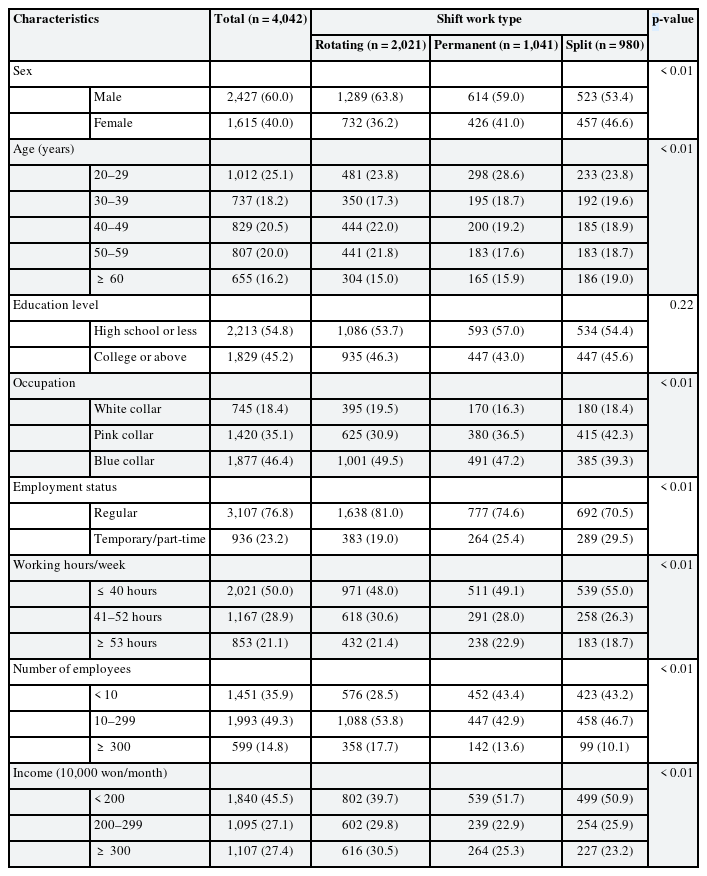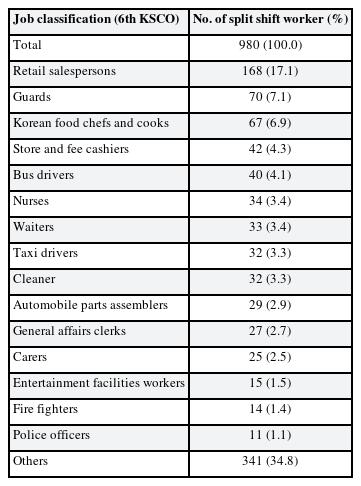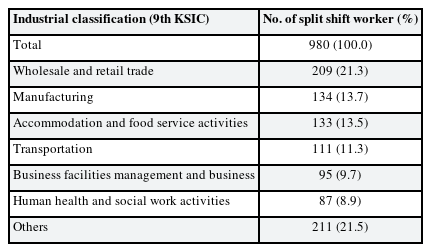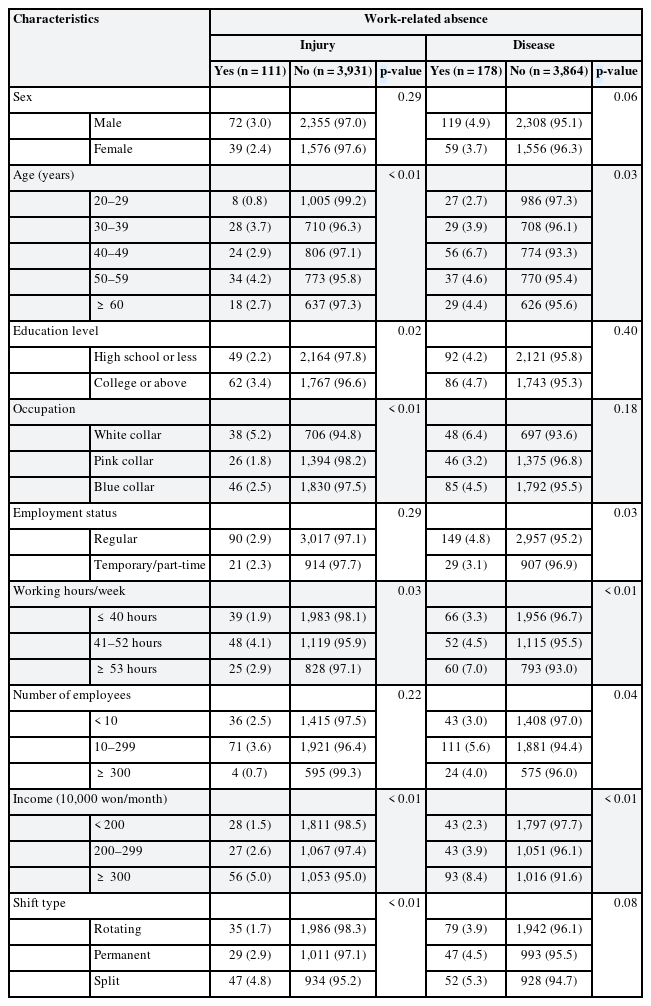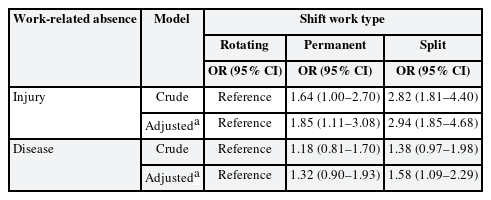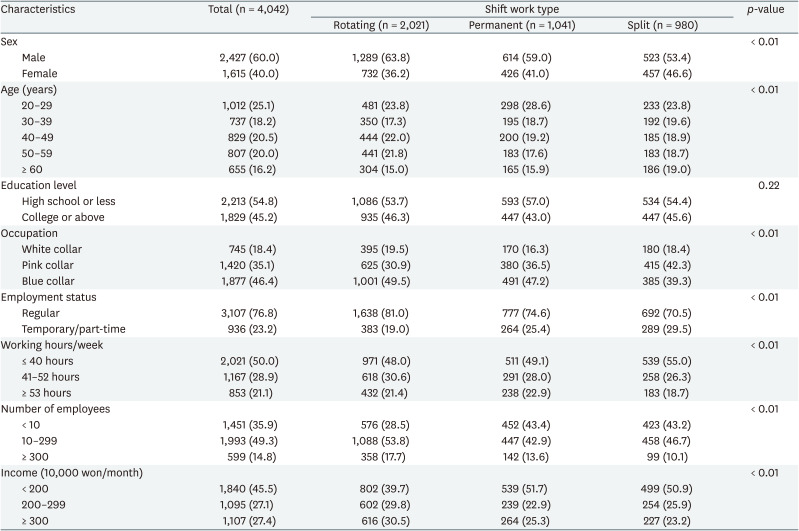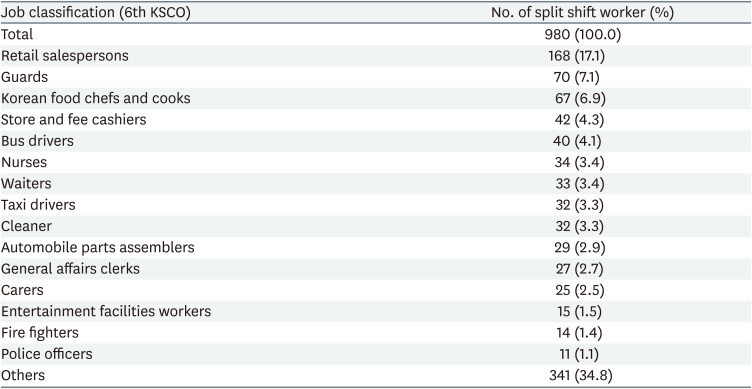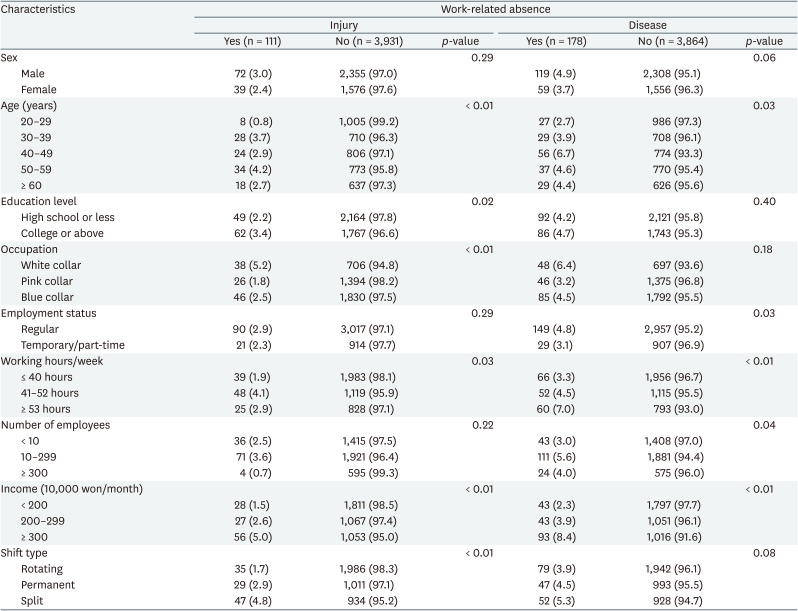Association between split shift work and work-related injury and disease absence
Article information
Abstract
Background
Shift work (particularly split shifts) has been noted among the working conditions that hinder sustainable work. However, little is known regarding the effects of split shifts on health. This study aimed to investigate the association between split shift work and work-related injury and disease absence.
Methods
This study used data from the fifth Korean Working Conditions Survey and included 4,042 paid shift workers. Shift work type and self-reported work-related injury and disease absence were investigated using a questionnaire. Logistic regression analysis was performed to investigate the association between split shift work and work-related absence with rotating shift worker as the reference group.
Results
Of the 4,042 shift workers, 980 (24.3%) were split shift workers. The adjusted odds ratio (aOR) of split shift for absence due to work-related injury was high at 2.94 (95% confidence interval [CI]: 1.85–4.68) and the aOR of split shift for absence due to work-related disease was also high at 1.58 (95% CI: 1.09–2.29) compared to rotating shift.
Conclusions
Split shift work leads to an increased risk of absences due to work-related injury and disease.
BACKGROUND
A report recently published by the International Labor Organization (ILO) identified inadequate work intensity, shift work (particularly split shifts), night work, fear of unemployment, unfair treatment, and harassment by colleagues as working conditions that hinder sustainable work.1 According to the survey conducted on a sample of American adults employed as wage employees by the Public Policy Polling in the United States in 2014, 3% of all employees are known to be working split shifts,2 even the concept of split shift work is unfamiliar, and only few studies exist on related health effects.
A “split shift” is defined by the ILO as a work type that includes more than one scheduled work shift per day3 and by the Korean Working Conditions Survey (KWCS) as a work type with more than four hours of unpaid breaks between shifts in one day. As noted above, split shifts are considered a suboptimal type of work, a negative effect to the individual's health. Indeed, a study of train workers revealed that split shifts are related to problems with fatigue,4 and research on bus drivers has shown a correlation between split shifts and drowsiness and accidents.56 However, other studies conducted in the United States and Canada with a representative sample of workers from all shift forms found no significant correlation specifically between split shifts and work-related injuries.78
Existing studies and reports on the effects that split shift has on health other than injuries have primarily associated split shifts with precarious employment. A Study revealed that many precarious workers work split shifts [3], and a study of temporary retail workers assigned to work split shifts reported that these workers often have short, divided working hours, are paid a low gross income, and are more stressed, which can make it difficult to for them to balance their work and personal lives [9, 10].
As noted above, split shifts appear to have adverse health effects; however, studies on the effects of split shifts on workplace injuries or accidents have shown inconsistent results.45678 Further, other research3910 has explained the potential for adverse health effects due to the employment instability and socioeconomic states of split shifts rather than examining the direct effects on health. In addition, there have not been any studies on Korean split shift workers in any aspect up until now.
In this light, this study aimed to identify the characteristics of Korean split shift workers through analysis of the major occupations and industries that the split shift workers belong to, and evaluate the effects of split shifts on health by examining absence due to work-related injury and disease among split shift workers.
METHODS
Participants
This study analyzed data from the fifth KWCS conducted in 2017 by the Occupational Safety and Health Research Institute. The KWCS was designed to improve the understanding of the overall work environment, such as work and employment type, occupation, industry, exposure to risk factors, benchmarking the European Working Conditions Survey (EWCS) and the Labor Force Survey in the UK. Via multistage systematic cluster sampling, one-on-one interview surveys were conducted through a household visit by a trained interviewer for 50,205 employees aged 15 or older, extracted from across the country using multistage systematic cluster sampling. The survey data were weighted with reference to the economically active population of Korea to obtain estimates of parameters for the entire economically active population. This weighting procedure first obtained the design weights (sampling weights) to account for sample selection, and then adjusted the weights so that the estimates coincided with the known totals for the population.
From the 50,205 respondents of the fifth KWCS, this study included wage workers over the age of 20. Self-employed persons without employees, self-employed persons/business owners with employees, unpaid family workers, and other workers were excluded from the study. Military personnel were also excluded from the study, and only shift workers were included in the representative sample. Further, those who did not respond to any of the questions about the variables used in this study or did not answer or refused to answer were excluded from this study. Responses of “other,” “don't know/no response,” and “rejected” were not used for analysis. 4,042 wage workers (2,427 men and 1,615 women) were included in the final representative sample of this study.
Main variables
Shift work type
Since only shift workers were included in the study, all participants were divided according to the shift work type, which was determined by the response provided to the question, “Which of the following is your shift type?” Responses of “weekday split shift” were defined as split shift, “permanent shift” was defined as permanent shift, and “shift/rotation” was defined as rotating shift. The rotating shift was set as the reference group.
Work-related absence
Absence due to work-related injury and work-related disease were used as dependent variables. Absence due to work-related injury was considered to be even one day of absence due to work-related injury, determined by the question, “How many days were you absent due to a work-related accident over the past year?” Responses of “no absence” were defined as no absence from work-related injury. For work-related disease, respondents were asked the question, “How many days did you miss work because of health problems created or worsened due to work (excluding accidents) over the past year?” Even one day of work-related disease was defined as absence due to work-related disease, and answers of “no days” were defined as no absence due to work-related disease.
Covariates
Participants' general and occupational characteristics were designated as covariates. General characteristics included gender, age, educational background, and self-rated health. Age was classified into the following groups: “20−29 years,” “30−39 years,” “40−49 years,” “50−59 years,” and “60 years or older.” Educational background was classified as “high school or less” and “college or above.” To determine self-rated health, participants were asked, “How is your health overall?” Responses of “very good” and “good” were classified as “good self-rated health,” while responses of “fair,” “bad,” and “very bad” were classified as “poor self-rated health.” Occupational characteristics included occupation, employment status, weekly working hours, workplace size, and monthly income. Occupations were classified based on 11 occupations from the Korean Standard Classification Occupations. Managers, experts, technicians, associate experts, and office workers were classified as “white-collar workers”; service workers and sales workers as “pink-collar workers”; and skilled workers in agriculture, forestry and fishery, craftsmen and related technical workers, equipment/machine operation and assembly workers, and simple laborers as “blue-collar workers.” Employment status was classified into 2 groups: “regular workers” and “temporary workers or daily workers.” Working hours per week were classified as “40 hours or less,” “41−52 hours,” and “over 52 hours.” Workplace size was classified based on the number of current employees in the participant's workplace and categorized as “less than 10,” “10−299,” and “300 or more.” Monthly income was classified as “less than 2 million won,” “2−2.99 million won,” and “3 million won or more.”
Statistical analysis
Survey sample weights were used in all analyses to produce appropriate estimates and standard errors. Chi-square tests were conducted to compare participants' personal and occupational characteristics according to shift work type. Logistic regression analysis was performed to estimate the adjusted odds ratios (aORs) and 95% confidence intervals (95% CIs) for absences due to work-related injury and disease among split shift workers with rotating shift worker as the reference group. These aOR was adjusted for age, marital status, education level, occupation, employment status, number of employees, working hours and monthly earning. All statistical analyses were performed using Statistical Package for the Social Science (SPSS) for Windows version 25.0 (IBM Corp., Armonk, NY, USA).
Ethics statement
All KWCS participants provided written informed consent for their voluntary participation. All identifiable participant information was deleted before data analysis. This study was approved by the Institutional Review Board of Ajou University Hospital (AJIRB-MED-EXP-20-504).
RESULTS
The 980 split shift workers comprised 24.3% of the total 4,042 participants. In terms of gender proportions, women comprised a higher portion of split shift workers than in other shift worker groups (n = 457, 46.6%). Further, with respect to age group, workers over the age of 60 (n = 186, 19.0%) took up the highest portion. Regarding occupation and employment status, the proportion of split shift workers was highest in service and sales (n = 415, 42.3%), and temporary and daily workers (n = 289, 29.5%). For working hours per week, those working less than 40 hours (n = 539, 55.0%) took the highest portion. Further, for workplace size, workers working in large workplaces with 300 or more employees comprised the lowest proportion for split shift workers (n = 99, 10.1%). Regarding monthly income, the proportion of people with a monthly income of 3 million won or more (n = 227, 23.2%) took the lowest proportion among split shift workers (Table 1).
In order to figure out the characteristics of Korean split shift workers, this study examined the occupations and industries that the split shift workers subject to the study are commonly employed in. Among the 980 total split shift workers, the three most common occupations were store salespeople (n = 168, 17.1%), security guards (n = 70, 7.1%), and chefs and cooks working in Korean cuisines (n = 67, 6.9%). Store and fee cashiers (n = 42, 4.3%) and bus drivers (n = 40, 4.1%) accounted for the next largest groups (Table 2). The industries with the largest proportion among the 980 split shift workers were the wholesale and retail industries (n = 209, 21.3%), followed by manufacturing (n = 134, 13.7%), lodging and restaurants (n = 133, 13.5%) and transportation (n = 111, 11.3%; Table 3).
Among the 4,042 participants subject to the study, 111 individuals (2.7%) had experienced work-related injury absence. The proportion of such individuals in their 20s (n = 8, 0.8%) were lower than that of all participants, and with respect to education level, the proportion of individuals educated until high school or less (n = 49, 2.2%) was lower. Classified by occupation, white collar (n = 38, 5.2%) workers comprised a higher proportion compared to that of all participants, while the individuals working 40 hours or less was lower (n = 39, 1.9%). In terms of monthly income, individuals with less than 2,000,000 KRW comprised a lower proportion (n = 28, 1.5%), and based on shift type, the proportion split shift workers were higher (n = 47, 42.3%). One hundred seventy-eight individuals (4.4%) out of the 4,042 participants suffered from work-related disease absence. Meanwhile, individuals in their twenties comprised the lowest proportion (n = 27, 2.7%) compared to other age groups, and classified by employment status, regular employees (n = 149, 4.8%) comprised a higher proportion. In terms of hours per week and monthly income, workers working 40 hours or less (n = 66, 3.3%) and individuals with monthly income of less than 2,000,000 KRW (n = 43, 2.3%) was low (Table 4).
The aORs and 95% CIs of work-related absence according to shift work type calculated using logistic regression are shown in Table 5. These aORs were obtained based on rotating shift workers being designated as the reference group, and are adjusted for general characteristics, such as gender, age, education level and occupational characteristics, such as occupation, employment status, working hours per week, workplace size, and monthly income. In split shift workers, the risk for absence from work-related injury and disease was significantly high. For split shift workers, the aOR for absence due to work-related injury was the highest, at 2.94 (95% CI: 1.85−4.68), and the aOR for absence due to work-related disease was also high, at 1.59 (95% CI: 1.10−2.31) compared to rotating shift workers.
DISCUSSION
This study used data from the fifth KWCS to examine the distribution of major occupations and industries of domestic split shift workers, investigate their general and occupational characteristics, and examine the relationship between split shift work and absence due to work-related injury and disease. The results showed that split shift workers were mainly employed as retail salespeople (17.1%) and the main industries were wholesale and retail trade (21.3%). Studies revealed that the risk of absence due to work-related injury and disease was high for split shift workers compared to rotating shift.
Split shift workers accounted for 2.71% (980/36,136) of all wage workers, similar to 3% previously reported in the United States. However, the proportion of split shift workers among all shift workers was 24.25% (980/4,042), which was higher than that of the United States (18.75%).2 An analysis of participants' characteristics based on shift work type indicated that there were differences in occupation, employment status, and monthly income in terms of their occupational characteristics. In particular, the proportion of service and sales workers was high among split shift workers, which was consistent with previous United States and ILO reports.23 The low income and high proportion of temporary and daily workers among split shift workers also corresponded to the results of previous studies showing that split shift workers were often found in precarious employment and had short, divided working hours and earn low wages.3910
The main occupations of split shift workers in Korea are retail salespersons, guards, chefs and cooks, store and fee cashiers, bus drivers, nurses, etc. Excluding guards, the main occupations that split shift workers in Korea existed were similar to those noted in previous reports from other countries.23
These findings can be classified into three different categories. First, some split shifts may be caused by the employees' quick return to work. If an employee works in the morning and then returns to work at night on the same day, it may be considered a split shift because there is an unpaid break longer than four hours and two work shifts are scheduled per day. Nurses would fall into this category. Second, split shifts are sometimes caused by the need to hire additional personnel during busy hours, such as rush hour or meal times. Examples that fall under this category would be retail salespersons, chefs and cooks, store and fee cashiers, and bus drivers. Indeed, the transportation industry often utilizes split shifts to satisfy peak demand.3 Lastly, workers who stay at work for a prolonged time period with unpaid breaks would comprise the third category. Guards who are on duty for 24 hours would be included in this category, since they stay at their workplace for extended periods of time but do not receive wages during sleeping hours.
When analyzing the relationship between split shifts and absenteeism to determine the effects of split shifts on health, it was found that the aORs for absences due to work-related injury and disease were high for split shift workers compared to rotating shift workers. As previously mentioned, there was no significant correlation between split shifts and work-related injuries in previous studies conducted in the United States and Canada.78 While there could be a few different causes leading to this study reaching a different result compared to previous studies, one cause is the different outcome. While this study utilized work-related absence as the outcome, previous studies used work-related injury. Also, the Canadian study may not be sufficient to evaluate split shift in its own, because in the Canadian study, split shift, on-call, and irregular shift was compiled into one classification. Equally, in the United States study, the work hours were not adjusted for. Finally, the characteristics of the split shift workers in the United States and Canada may differ from that of the Korean split shift workers, as is shown from guards taking up a high portion of split shift workers only in Korea.
In other existing studies, the negative effects in health that split shift workers suffered from were interpreted as having been caused by many of the split shift workers being temporary/part-time workers,310 earning less income,101112 or their working hours being too long, short, or irregular.1011 However, in this study, we were able to obtain a significant outcome on the relationship between split shifts and absenteeism even after adjusting for the employment type, income, and working hours.
The reason that rotating shift was set as the reference group was because we thought that it could be an alternative option to split shift by employing more employees or changing shift length. In the contemporary society, it is difficult to completely be free from shift work because of the increasing use of shift work and irregular work hours, which are believed to be driven by major societal changes occurring from a decline in manufacturing and the rise in the service economy.13 As such, in consideration of the negative effects that shift work has on the health of individuals, there have been constant efforts to find the types and length of shift work that have less impact on the health of individuals. Under such expectation, this study aimed to compare the risks of split shift to a rotating shift.
In order to establish rotating shift as a reference group, we check whether split shift workers include the risk factors that rotating shift workers have, and this study compared the 2 groups on night work, evening work, working on Sunday, working on Saturday, and quick return compared to day worker (Supplementary Table 1). Also, in order to confirm whether split shift workers also possess higher risks towards work-related absence compared to the day worker group, this study put day workers as a reference group and conducted identical logistic regression. The aORs for absence due to work-related injury and disease for split shifts were significantly high compared to day workers (Supplementary Table 2).
Several possible mechanisms may contribute to this outcome about high aOR of split shift for work-related absence. First, the break between shifts cannot be considered a “complete break” with the worker being able to rest sufficiently. Split shift workers take breaks longer than four hours in a day; however, there are possibilities of the workers not being guaranteed sufficient rest during that time. There was no assessment in the KWCS or previous research of where split shift workers take their breaks. When split shift workers have long breaks between shifts, factors such as whether rest areas are provided and, if they are, whether they are separate from the workplace, as well as whether employees are completely excluded from work during breaks, have an important impact on the quality of breaks.
Second, employees are often at their workplaces for an increased period of time. For split shift workers, long, unpaid breaks lead to more time spent at work, which can makes the work day much longer.11 In addition, split shift workers often work early mornings and late evenings, and therefore may be prevented from spending time with friends and family,12 experience work-family conflicts,2141516 and feel unsatisfied with the balance between their working hours and personal life.16 For these reasons, in the United States, California legally protects workers by paying an additional hourly wage to split shift workers.17
Third, split shift work tends to be intensive. Split shift workers in small retail stores, supermarkets, and restaurants are known to work rigorously during busy times.11 Increased workload resulting from such work can contribute to work-related injury or disease. An increase in mental workload was found to be associated with occupational accidents1819 and long-term sickness absence20 according to a study of nurses, while an increase in physical workload was shown to be associated with fatigue21 and long-term sickness absence22 according to a study conducted in Denmark.
Finally, split shift work is highly vulnerable to short shift intervals (quick return, intervals of < 11 hours between the end of one shift and the start of the next). The association between quick return with fatigue and sleep are already well known through multiple studies.23242526 Also, based on studies conducted in Finland and Norway on hospital workers,2728 along with a study conducted in Finland on retail workers, quick return also leads to higher risks of sickness absences with a dose-response relationship.29 As split shift work includes at least 2 shifts in one day, there is a high likelihood of split shift workers being exposed to short shift intervals. Although this study desired to include quick return as a variable, this study decided not to include it because of the difficulty of reflecting the characteristics of short shift intervals within a day of split shifts workers that work 2 or more shifts in one day, since the survey term of quick return in the fifth KWCS was different from the dependent variable (1 month), and the standard of the survey question was the “whether there were instances where the time that the worker returns to work the next day after leaving work was less than 11 hours.”
This study has several limitations. First, because it was a cross-sectional study, it is difficult to elucidate the causal relationships between split shifts and absence due to work-related injury and disease. Accordingly, further studies using longitudinal designs will be required. In addition, this study failed to consider all variables that could affect absenteeism, such as underlying medical history or lifestyle habits. Data related to the presence of acute and chronic diseases, smoking, and drinking could not be obtained from the fifth KWCS. Finally, although self-reported data on absenteeism are usually considered reliable and valid,30 a slight recall bias may occur. This study intended to minimize such recall bias by classifying the absence based on a yes/no. Also, as the response on whether the absenteeism was work-related was classified based on self-reported responses, there is a possibility of the responses being subject to misclassification. Despite such a possibility, sickness absence itself is considered as being commonly used as an indicator for monitoring work-related health.31 Further, this study conducted a 2-step analysis, only asking the participants having experienced sickness absence on whether the participants have ever experienced absence due to work-related causes, the risks of the absence being misclassified is probably relatively low.
A strength of this study is that it was able to secure a relatively large number of samples by using a national survey data, which is representative of Korean workers. Further, this study is the first study on split shift in Korea. Another strength of this study is that work-related injury and disease were used as separate outcome indicators.
In the future, it may be necessary to study the effects of split shifts on indicators other than absences and the mechanisms affecting health. In addition, more detailed understanding of split shift may be possible if studies are conducted on split shift workers' specific occupations or industries (especially retail workers and guards in Korea), the effects of waiting time and waiting space of split shift workers and the effects of combining split shifts and night work.
CONCLUSIONS
This study revealed that split shifts increased the risk of absenteeism due to work-related injury and disease, even after adjusting for personal and occupational characteristics. Split shifts are thought to increase the risk of work-related injury and disease and affect personal health, quality of life, and social costs; however, there is still a lack of interest in split shift workers in Korea. To improve workers' welfare and health, it would be helpful if measures to protect workers from health problems caused by split shifts are created based on the current situation of split shift workers in Korea.
Notes
Competing interests: The authors declare that they have no competing interests.
Author Contributions:
Conceptualization: Ko K, Jeong I.
Data curation: Ko K.
Formal analysis: Ko K.
Investigation: Ko K, Park JB, Lee KJ, Jeong I.
Writing - original draft: Ko K.
Writing - review & editing: Ko K, Park JB, Lee KJ, Jeong I.
Abbreviations
aOR
adjusted odds ratio
CI
confidence interval
EWCS
European Working Conditions Survey
ILO
International Labor Organization
KSCO
Korean Standard Classification of Occupations
KSIC
Korea Standard Industrial Classification
KWCS
Korean Working Conditions Survey
OR
odds ratio
References
SUPPLEMENTARY MATERIALS
Supplementary Table 1
The prevalence of adverse working conditions of rotating and split shift compared to day work
Supplementary Table 2
Adjusted ORs for work related absence by shift work type compared to day work

